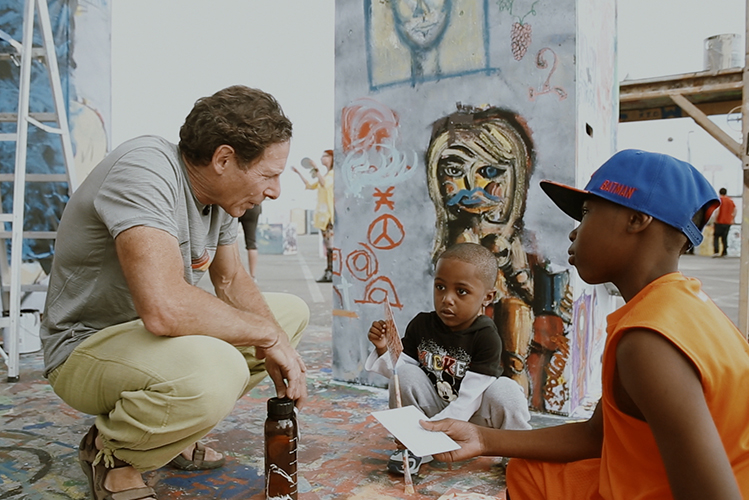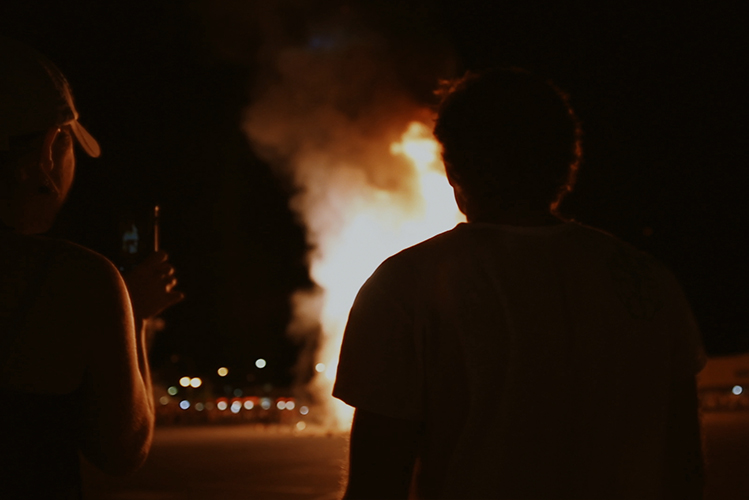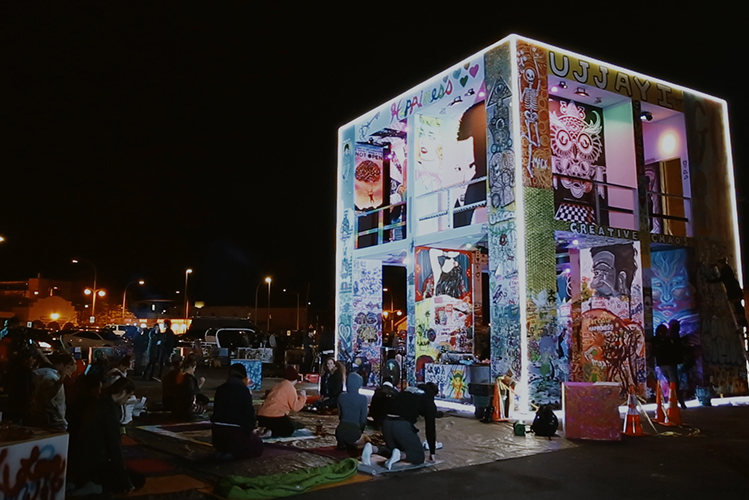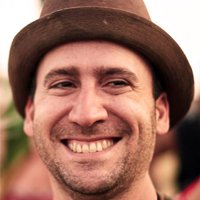Originating at Burning Man, the Life Cube travels the globe, encouraging goal setting, creativity and helping to bring communities together. Arlo Laibowitz captures the magic of this powerful art project in a brand new film.
Why would a participatory art project that was first made at Burning Man be interesting and transformative to a city's community? What role does goal setting, experiencing flow, and being playful have in that? And how does a project like this help nurture and increase the participants’ happiness, by connecting and creating community? I tried to answer all of these questions, and more, in the documentary film Rainbow of Chaos, that I made about The Life Cube in Las Vegas.
From Burning Man to Las Vegas
I met Scott Cohen at Burning Man some years ago. Burning Man is an annual arts and music festival, that takes place in the Black Rock desert of Nevada, United States. It's a temporary city of 70,000 people which exists for just one week a year.
Burning Man is an experiment in community and art, guided by principles that include self-reliance and self-expression, gifting, leaving no trace, and decommodification. No money is exchanged at the event, and participants bring everything that they need to survive in the desert and want to gift to others.
The event is considered simultaneously as one of the world’s biggest parties, and one of the world’s largest interactive, participatory art gatherings. The ‘playa’ is filled with interactive sculptures and structures, some of which are burned during the week of the event.
Cohen's positive experience with creating life goal lists had made him convinced that he needed to gift his art project, The Life Cube, to the Burning Man community. A 'mailbox' that invited participants to write down their goals, dreams, wishes, and aspirations, and place it in within the art installation. During the burning of it, these messages would be sent up to the universe, to manifest them.
RELATED: 8 manifestation techniques
In later versions, Cohen had expanded this idea, by adding the opportunity for participants to paint, draw and write on the installation. Furthermore, he invited hosts and musicians to use the space as a place to come and do yoga sessions, workshops and performances. The Life Cube has become a community project, carried by so-called ‘Cube-ists’. People that have seen the power of the installation changing their life, and the life of others.
The Life Cube is the subject of Rainbow of Chaos
After three Life Cubes at Burning Man, Cohen now had a new goal: taking his experience from Burning Man to cities around the world. The first non-Burning Man version of the Life Cube happened in Las Vegas in 2014, an event that lasted weeks , culminating in a city burn of the installation. I wasn't there then but came to document the second version, in 2016, that lasted for a month. What I encountered was an installation that aimed, and succeeded, in providing a few distinct things:
- the power of goal-setting,
- the joy of creativity, flow and playfulness,
- connecting and creating a community.
What do these things have in common? They are all considered instrumental in creating and maintaining individual happiness levels. Let's take a look at how exactly the Life Cube promotes these three different spheres.
1) The Life Cube: goal setting
The genesis of the Life Cube art installation is Cohen's conviction that writing down your goals, dreams, wishes and aspirations increases the chance of them happening.
Cohen has experienced this first-hand throughout his life and has seen this power working for others as well. Indeed, goal setting has been identified in studies as a major component in our sense of happiness. Cohen is described by others as a force of nature, someone who moves mountains. That attitude is infectious. He invites people to write down their goals, dreams, wishes and aspirations on so-called ‘wish sticks': postcards that can be dropped into slots in the installation.
“The Life Cube has become a community project, carried by so-called ‘Cube-ists’. People that have seen the power of the installation changing their life, and the life of others.”
Cohen's philosophy behind this is simple but effective. By writing down your goals and dreams, you start a process of envisioning them, considering how to pursue them, breaking them down into the steps that are necessary, and then actively pursuing them. Indeed, according to Sonja Lyubomirsky in her book The How of Happiness, setting goals is an effective strategy of raising our happiness, and works best with goals that are intrinsic, authentic, harmonious, flexible and active.
In an interview segment that only partially made the final cut of my documentary, I extensively asked Cohen about how this goal setting could be misunderstood for the Law of Attraction and other pseudoscientific ideas. He emphasized that setting goals and writing them down starts a process that one works through, much along the lines of scientifically-backed goal setting: setting goals and intentions in writing them down helps envision their outcome and process, creates ownership and identifies blockers and creates accountability for these goals.
Life Cube creator Scott Cohen with participating kids
When hearing stories at the Life Cube about how the installation had changed the lives of people involved, from small things like someone finally deciding to propose and marry their partner or having a short-term goal to be more friendly and compassionate to others, to bigger things like artists being able to further pursue their career professionally, or people making radical life changes for the positive, it was clear that the Life Cube succeeded in installing more happiness in people through goal setting activities.
2) Becoming child: creativity, flow and playfulness
Alongside goal setting, another big part of the happiness-inducing qualities of the Life Cube lie in what I've dubbed in the documentary “becoming child”. The Life Cube invites participants to be creative themselves, by painting on the installation, participating in interactive workshops, and by either enjoying music performances or participating in them yourself.
The effect of creativity on our happiness and well-being is a subject that has been extensively studied. Creativity helps us be happier because it enables us to express and process emotions; it activates the reward regions of our brain, and it helps us focus and enjoy the moment, also known as creating flow.
Apart from this, something I heard a lot at the Life Cube is that creativity helps us reconnect with our inner child and be more playful. In fact, playfulness as a way to nurture our happiness is an idea that has been proposed by Bernard de Koven, and is backed by research that shows a clear correlation between playfulness and our sense of happiness. The Cube creates an environment for people to be creative, to experience flow, and do all of that in a playful way, that instils happiness.
RELATED: What playfulness can do for your relationship
3) A happy Rainbow of Chaos: community
Possibly the biggest mission of the Life Cube is to connect the community through art. The effect of community on our level of happiness has been documented in different studies, showing that there are long-term positive effects of community, in strengthening our relationships, that lead to longer and happier lives.
Cohen has expanded and grown the community of Cube-ists, which take ownership of different parts of the project and make his vision of a “rainbow of chaos” come true. This community is made up of different layers or smaller communities. First of all, there is the inner core of Cube-ists, which together with Cohen build and create the installation.
Secondly, there are local event organisers, artists, musicians, yoga teachers and workshop hosts, that join in having a level of ownership of the space, and create part of the ‘permanent' artwork on the Cube, and its peripheral events.
“By writing down your goals and dreams, you start a process of envisioning them, how to pursue them, breaking them down into the steps that are necessary, and you start actively pursuing them.”
Thirdly, there's the local community of Burners [active participants that regularly go to Burning Man and satellite events], that was involved in the overall event, and especially the burn of the installation.
Fourthly, there are the local residents and incidental passers-by, that became enthusiastic after visiting the installation once, and got actively involved in maintaining it, keeping it safe, and helping out with chores.
Fiinally, there is the community of schools, which Cohen involved by going to talk to thousands of children and gifting these schools ‘satellite cubes’ that children could paint and put their wish sticks in.

Up in flames: the burning of wishes helps manifests them
Studies show that community strengthens relationships and has a positive emotional result, especially in shared novel experiences and sharing positive events. The Life Cube exemplifies this, in its creation of community around this ‘novel’ experience and positive event.
For example, most American inner cities are not the most friendly or positive environments. There are, also in Las Vegas, problems with crime, drug use, homelessness and the overall rundown state that these downtown areas are in.
The site of the Life Cube was like an oasis of community amid all these problems. A homeless man would volunteer in keeping the installation clean, while a local artist was painting a mural, and the inner core of Cube-ists would do maintenance and prepare structural elements and lighting.
“Studies show that community strengthens relationships and has a positive emotional result, especially in shared novel experiences and sharing positive events.”
Meanwhile, a group of school children would visit the Life Cube for a quick session of painting and an inspirational talk by Cohen. Afterwards, some local volunteers would start prepping a musical performance, while another local volunteer was hosting a yoga session.
Simultaneously, “Burners” would gather for a fire safety meeting in preparation of the burn. Throughout the day local residents would visit, experience the installation, paint, and write their wish sticks. People from these different communities would interact, where normally they would not: just this interacting in itself created an overall connectedness and happiness at the Life Cube.

The Life Cube is a creative hub for community
The Life Cube: changing the world?
In the documentary, Cohen is not modest about his goals: he clearly wants to change the world, by bringing Life Cubes to different cities and countries, spreading the effects of goal setting, creativity and community. It’s an ambitious goal and statement, but when looking at the magic that was created in Las Vegas, I also believe it's totally achievable.
As Flash Hopkins, one of the founders of Burning Man and ally of Cohen in the project says in the documentary: “If he can change one person, then he has already done it.” I would argue that Cohen has indeed changed many lives, both at Burning Man and in Las Vegas. I invite you to watch the full documentary, Rainbow of Chaos, and find out for yourself. Art and community can make us happier. ●
All images: © Arlo Laibowitz
happiness.com | The fine art of being: learn, practice, share
Are you a happiness.com member yet? Sign up for free now to:
■ enjoy our happiness magazine with practical life tips
■ share and support others in our happiness forum
■ learn with free online classes in our happiness Academy
Written by Arlo Laibowitz
 Arlo is a filmmaker, artist, lecturer, and intermittent practitioner of metta meditation and morning yoga. When not dreaming about impossible projects and making them happen in the most impractical ways possible, he journals, listens to jazz, or cuddles with his better half.
Arlo is a filmmaker, artist, lecturer, and intermittent practitioner of metta meditation and morning yoga. When not dreaming about impossible projects and making them happen in the most impractical ways possible, he journals, listens to jazz, or cuddles with his better half.




Join the conversation
You are posting as a guest. If you have an account, sign in now to post with your account.
There are no comments to display.